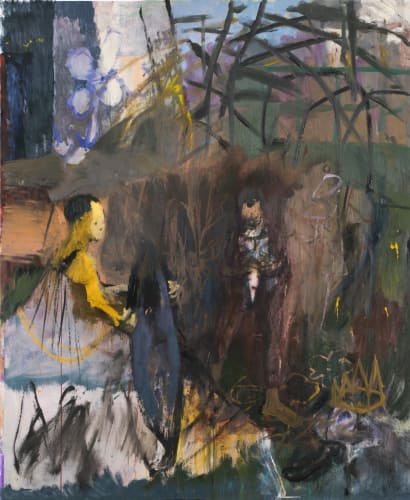Ovcharenko gallery represents Leonid Tskhe’s personal exhibition 'Boy and Clew' with the new series of painting and drawing.
It is well-khown the dependence of human optics from the age – memory focus has a vector of different remembrance at different ages. Leonid Tskhe has a little daughter and the artist starts to apply to his own childhood more often. Important memories of his father, his child impressions and his own experience as a father turn out in the paintings and drawings called as 'The Boy and a Clew'.
Tskhe depicts himself at all new paintings and he is a hero who looks and acts like a fairy-tale character hidden under the mask or vested in superpower magic dress. But there is no personality from the conceptualism art point of view, gaping between artist and personage is minimal. Circumstances and situations are fictional but in the same time are realistic. Sometimes it is difficult to realize where the landscape with the river is coming from at the canvas? — is it coming from the personal history, vacation’s photos, magazine pictures? When and where was it made?
Painting is able to tell a story, the color becomes a narrative itself. Tskhe’s plastic language lives according to the law of native language where exist the mistakes, corrections, bloopers and different speech registers. Painting for the graphic artist is a self-education process to a certain degree. One of his art main attribute becomes an non-obviousness of the artistical decisions: it’s search escalated, the selection is devoid of automatism, the objectives are considered — this dynamic status is especial valuable.
Now it is difficult to imagine what was at the 1990s — period of the artist growing up. The irony and the seriousness are balancing on derisive seesaw at that time. This was the time of “liberty for everybody”: teenagers left to themselves (what can be better when you are 12?) and resided their life together with the parents generation. His farther was a musician at Russian folk orchestra that why among his sun children’s experience was a common life behind the scene of soviet culture’s houses and unusual things from the foreign tours. The artist growing up is congruent with the appearance of free market not only material but emblematic values. Tskhe and his peers are the first generation in Russian art whose interest of modernism and Avant-gard is not a political choice.
When in 2007 Tskhe graduated Ilya Repin State Academic Institute of Fine Arts, graphic faculty, Saint-Petersburg Arts Academy was far away from its present fame between Tokyo and Venice. Andrey Pakhomov leaded his creative workshop, had a reputation as a fine book artist but only a small circle of friends and students knew about his canvas’s neo-expressionism. Contemporary painting was not such popular as now. Since then much has changed. The master who separated Leonid from his another students, died. Young artists with the academic background stepped into the art scene. Tskhe was a member of “School for young Artist” of the St. Petersburg Pro Arte, was a lecturer of graphic faculty for The Arts Academy, created with his classmate the group “North-7”.
It is still possible to see the paintings and mosaics with the sun, rainbow, fairytales animals and happy children on the back of schools and kindergartens. Such places with the piece of Soviet monumental art covered by naive and ruffian pictures. Describing its, Tskhe matched it as “artistry school backyard” which can characterized his method in figurative sense.
It is still possible to see the academic “double staging” in the artist works, but now he is already far away from student graphic skills. Now he used to choose a canvas with its dimension and depth instead of paper plane, as the author is interested in proportions and monumentalism, spontaneity and improvisation. All that’s taking place in his new works describing as “teenagers are digging in the mud” but the teenager come directly form Michelangelo, Velasquez, Maurilio, Picasso, Petrov-Vodkin. Using the variation on old Masters, the artist demonstrates that he belongs to the common practice of painting through his sensation.
Leonid Tskhe doesn’t conceal that all his stories are deeply personal. But there is no place for popular discussion concerning “injury” in his art as the painter puts his foot over his workshop — he stops to scaring and finds a balance between freedom and fear. Depiction is not a injury but a dream: something that he wants come back again and again.
Tskhe’s depiction space is full of internal multidirectional movements, nothing is static, maestria is hidden under the plurality of notes.
Growing up of the child, forwardness to unknown result, the evolution of the painting style — it is all about the movement. The main content of the new painting and watercolors become a movement, changes of rolls and conditions. Tskhe is in the middle of this process: looking back, he remembers his childhood and his father, looking forward he sees his one year old daughter. He is discoursing about it as an artist, trying to see himself: “I have not fully seen myself yet”, — he thinks so.
Tskhe unravels the clew in which connected the stories of his parents, childhood, friendship, study and arts. The painting and life come together — human never let the artist go for a long time and the other way round. As the result of this coordinated movements the painted complexity resolves and turns of clarity of vision.
Pavel Gerasimenko

